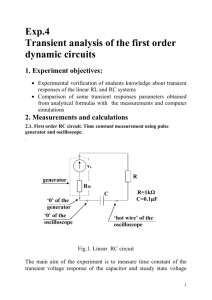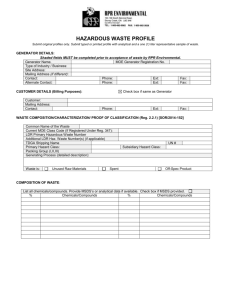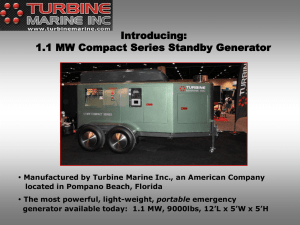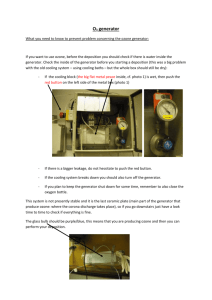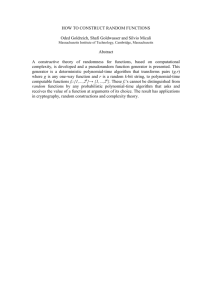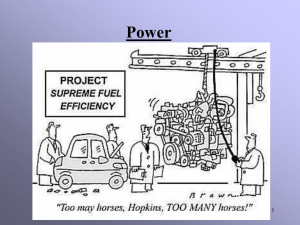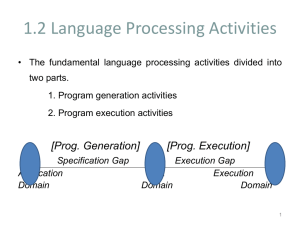generator_systems_handout_-_revision_2_
advertisement
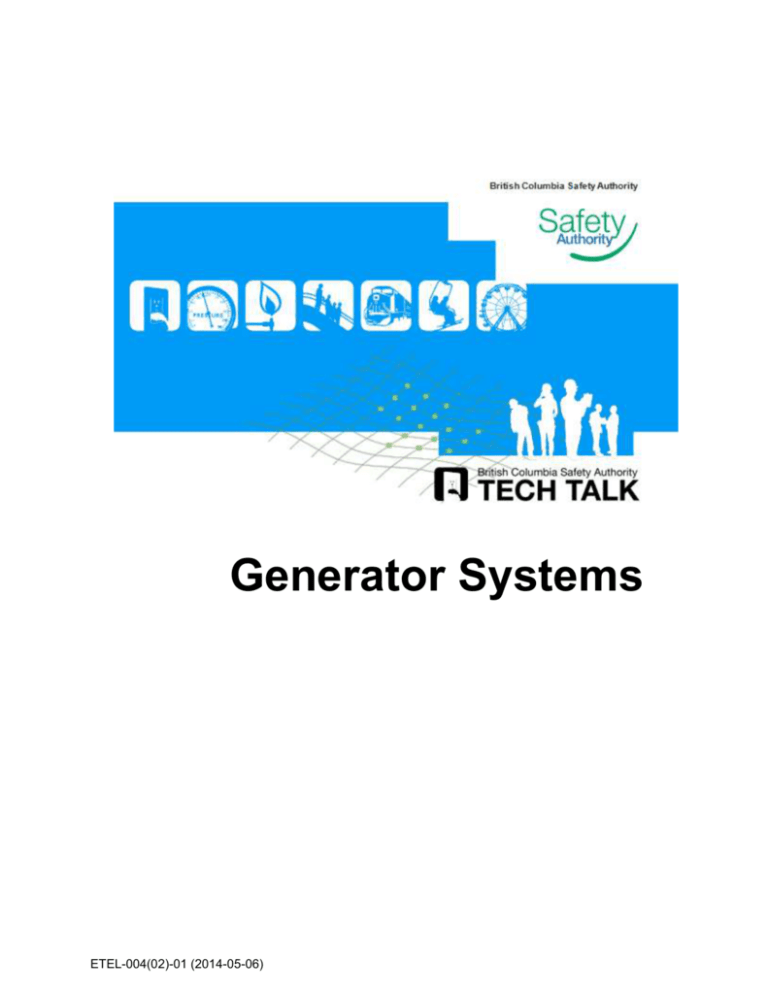
Generator Systems ETEL-004(02)-01 (2014-05-06) Table of Contents GENERAL REQUIREMENTS............................................................................................................................... 2 Emergency electrical power supply............................................................................................................... 2 Standby electrical power supply ..................................................................................................................... 3 Other authorities having jurisdiction .............................................................................................................. 3 Use of approved equipment .............................................................................................................................. 5 GENERATOR LOADING AND SIZING ........................................................................................................... 6 How to size a generator ...................................................................................................................................... 6 Single family standby example ........................................................................................................................ 6 Alternate Single Family Standby example……………………………………………………..7 Load calculation for a complete single family dwelling ........................................................................ 8 Commercial standby example ......................................................................................................................... 9 Generator loading summary ............................................................................................................................. 9 Emergency standby systems ........................................................................................................................ 10 TRANSFER SWITCHES ...................................................................................................................................... 10 Designing the transfer system ...................................................................................................................... 10 Transfer switch sizing ....................................................................................................................................... 11 Manual transfer switches................................................................................................................................. 14 Transfer switch - dual breaker type diagram ......................................................................................... 14 Normal hydro operation diagram ................................................................................................................. 15 Generator operation diagram ............................................................. Error! Bookmark not defined. GROUNDING AND BONDING ......................................................................................................................... 16 Grounding of generators.................................................................................................................................. 16 2 pole generator panels systems ................................................................................................................ 23 GENERATOR WIRING METHODS................................................................................................................ 24 Permanent standby systems ......................................................................................................................... 24 Portable generator wiring methods ............................................................................................................ 25 Panel mount receptacles ................................................................................................................................. 26 © British Columbia Safety Authority, 2015 1 GENERATOR SYSTEMS GENERAL REQUIREMENTS Emergency electrical power supply Definition: The in-house generation of electrical energy for supplying a load requiring emergency power when the normal power supply fails. The BC Building Code mandates the installation of emergency electrical power supplies. References BC Building Code “Life safety equipment” Fire alarm and emergency voice communication systems Fire fighters elevators and elevators serving floors above the first storey in a high building Fire protection water supply pumps Smoke control systems Fans required for smoke venting Emergency lighting Exit signs that depend on electrical power supplied to the building CSA Standard C282-09 Emergency electrical power supply for buildings Covers all aspects including initial installation, performance tests, maintenance and scheduled testing 11 major sections Includes references to other installation codes Other publications referenced in CSA C282-09: Can/CSA–B149.1-05 Natural gas and propane installation code C22.1-09 Part 1 Canadian Electrical Code C22.2 No. 100-04 (R2009) Motors and generators C22.2 No. 141-02 (R2007)Unit equipment for emergency lighting C22.2 No. 178.1-07 Requirements for transfer switches Can3–C235-83 (R2006) Preferred voltage levels for AC Systems C282 Logbook-09 Maintenance logbook CSA Z32-09 Electrical safety & essential electrical systems in health care facilities © British Columbia Safety Authority, 2015 2 Emergency power supply system installations: Equipment must be CSA C282-09 approved Equipment including transfer switches shall be approved for the purpose Additional requirements for Health Care Facilities Design to be certified by BC registered P.Eng Must meet BC Electrical Code requirements Standby electrical power supply Definition: A reserve or substitute power supply Installed by the owner as a matter of convenience when normal Hydro power is interrupted BC Building Code and BC Electrical Code Section 46 do not apply Other local bylaws (generator location or noise) or other Safety Codes may apply Other authorities having jurisdiction Building inspection: Installation requires structural support (i.e. roof/deck mount) Location in relation to windows / building openings Exhaust emissions (carbon monoxide) Area subject to flooding Bylaw enforcement: Noise generated Location of generator (too close to neighbors) Gas inspection and permits may be required: Where natural gas or propane is used as fuel At -5C, propane available as a vapor (fuel) is approximately half the volume of the tank. At -28, propane will not vaporize. Clearance requirements from combustibles should be considered. © British Columbia Safety Authority, 2015 3 Fire Services may need to be consulted depending on the: • Amount of fuel that will be stored on site (gas or diesel) • Location of fuel tanks • Construction of fuel tanks • Accessibility for fire fighting Electrical inspection authorities: Electrical permits required prior to doing electrical work Electrical Safety Regulations Work performed by qualified workers Installation must comply with BC Electrical Code © British Columbia Safety Authority, 2015 4 Use of Approved Equipment Use of approved equipment: See Electrical Safety Regulation, Section 21 – 1(a) See BC Electrical Code, Rule 2–024 See BCSA Information Bulletin B-E3 071019 3 Approved Certification Marks for Electrical Products Beware of counterfeit equipment Offshore generators may not be approved but are available in Canada Electrical Safety Regulation Section 21 – 1(a) Certification or approval mark required for electrical equipment Subject to subsections (3) and (4), a person must not use electrical equipment in British Columbia, or offer for sale, sell, display or otherwise dispose of electrical equipment for use in British Columbia, unless the electrical equipment displays a label or mark as follows: (a) a certification mark Canadian Electrical Code Rule 2 - 024 Use of approved equipment Electrical equipment used in electrical installations within the jurisdiction of the inspection department shall be approved and shall be of a kind or type and rating approved for the specific purpose for which it is to be employed. © British Columbia Safety Authority, 2015 5 GENERATOR LOADING AND SIZING How to size a generator The code does not have specific rules to guide us for this task. Rules to consider: Rule 8 - 104 sub rules 1-5 o Sub rule (1) says the rating of a feeder or branch circuit is based on the rating of the overcurrent device or conductor ampacity, whichever is smaller. o Sub rule (2) states the calculated load on a circuit shall not exceed the ampere rating of the circuit. o Sub rules (3), (4) & (5) provide requirements to determine whether circuits are considered continuous or not, and loading of panel boards based on whether equipment is rated for use at 100% or 80% of the equipment nameplate ratings. Rule 8 – 106 (3), (5) & (8) o Sub rule (3) indicates we may use transfer switches/panel board or automatic systems such as load misers to control loads on a circuit or system o Sub rule (5) allows the installer to consider cyclic loads that can be demonstrated to be predictably intermittent or cyclic as you may encounter in commercial process or manufacturing process facilities o Sub rule (8) provides the use of maximum demand loads over a 12 month period to be used when calculating service or feeder ampacity in an existing installation. Other things to consider: Are loads intermittent or continuous? Check with the manufacturer of the generator for loading factors. Single family standby example Well pump 8A x 240V 1920 Fridge circuit (1 receptacle) 8A x 120V 960 1 general lighting / receptacle circuit 12A x 120V 1440 2 pole kitchen appliance circuit (2 receptacles) 12A x 240V 2880 Total or © British Columbia Safety Authority, 2015 7200W 30A 6 Notes: Rule 8 - 304 Sub rule (1) 12 outlets on any 2-wire branch circuit Sub rule (2) states that each outlet = 1 amp Sub rule (3) allows more diversity if the load is known, therefore lights could be added at their rating. Therefore, a generator and feeder rated at 7.2kW would be required. Please note that the manufacturer’s generator loading factor should be considered when sizing the unit. Alternate Single family standby example Well pump 8A x 240V 1920 Fridge circuit -1 receptacle 8A x 120V 960 1 lighting circuit 8 lamps x 50 watts 400 2nd lighting circuit feeding 10 lamps x 50 watts each 500 1 general purpose circuit feeding total of 10 outlets 10 outlets x 120V x 1 A 1200 1 general purpose circuit, total 4 outlets 4 x 120V x 1A 480 1- 1pole kitchen appliance circuit (5-20R) 16A x 120V 1920 W Total 7380 W In this example we have installed lighting equipment with a known load. The general logic of Rule 8-304(3) which allows us to increase the number of outlets on a circuit where we have a known load provides the rationale for this method. We have changed the kitchen receptacle to circuit feeding only one kitchen counter outlet rated 20 amps and 120 volts. We have reduced the total number of receptacles on the circuit feeding the entertainment equipment and the general purpose circuit. We have used the provisions of 8-304(2) to arrive at this reduced load for these circuits. This method may provide some relaxation to calculated loads but requires planning at the initial stage of the job. When reducing load calculation requirements for lighting and other loads as shown in this example it is recommended you communicate with your local inspection authority before proceeding. Therefore, a generator and feeder rated at 7.2kW would be required. Please note that the manufacturer’s generator loading factor should be considered when sizing the unit. © British Columbia Safety Authority, 2015 7 Load calculation for a complete single family dwelling BASIC 5000 RANGE 6000 OTHER LOADS @ 25% HWT 4500W x 25% 1125 Dryer 5000W x 25% 1250 Hot Tubs 5000W x 100% 5000 BB Heat 9000W x 100% 9000 Total 27375W @ 240V = 114A Service size installed Transfer switch to be sized to service Generator sized to calculated load 200A 200A 27.4kW Sample Loading Guide: © British Columbia Safety Authority, 2015 8 Commercial standby example Compressor circuit 8A @ 240V 1920 Cooler circuit (hard wired) 10A @ 120V 1200 2 general lighting circuits 2 x 12A @ 120V 2880 (general use outlets) 1 circuit supplying cash registers 6 plugs 6A @ 120V 720 (fixed load) Total 6720W 6720 X 1.25 = 8400W Therefore, a generator and feeder rated at 8.4kW is required. Note: Rule 8 - 104(3) indicates that in this type of occupancy, the load is considered to be continuous. As the Code considers commercial loads as being continuous, the calculated load of 6720W is multiplied by 125% to determine minimum generator and circuit sizing 6720 x 1.25 = 8400W Therefore, a generator and feeder rated at 8.4kW would be required. Generator Loading Summary Generator must be sized to the load Calculated or connected Sized to allow motor starting Add 20% Or use running and peak ratings Automatic load shedding permitted Must automatically shed loads to stay within generator load rating Manual load shedding is not permitted for residential installations. Manual load shedding may be permitted for commercial installations if an operating permit is in place. © British Columbia Safety Authority, 2015 9 Where an electrical operating permit is held for the installation, the following terms and conditions apply for manual load shedding at commercial and industrial: A suitable training program is developed and provided to those employees authorized to perform the manual load shedding Clear written instructions are posted at the stand-by power location The load transfer is by manual operation Manual load shedding will be acceptable for commercial and industrial sites only Emergency standby systems Rule 46 - 100 states that emergency systems and unit equipment shall have adequate capacity and rating to ensure the satisfactory operation of all connected equipment when the principal source of power fails. These required systems are specifically designed for the particular facility for which they are intended to protect against power failure. Do not add load to these systems without first doing a thorough analysis. Canadian Electrical Code Rule 46 - 100 Capacity Emergency power supply and unit equipment shall have adequate capacity and rating to ensure the satisfactory operation of all connected equipment when the principal source of power fails. TRANSFER SWITCHES Designing the transfer system What does the generator supply? Emergency loads (hospitals, fire pumps, fire alarm, etc.) Non-emergency loads (not life safety systems) Emergency loads Hospitals and other health care facilities Designed by and specified by an electrical consultant. Electrical contractors should be aware of the following requirements: Rule 24 – 304, CSA C22.2 No. 178, and CSA Z32-09 o Requirements for speed of transfer for vital and delayed vital circuits and circuits are to be automatically transferred o Conditional branch may be automatic or manual transfer © British Columbia Safety Authority, 2015 10 Emergency power for building life safety systems: Covered in detail by the building code and CSA C282-09 Must be automatic May require protected feeders if the requirement for high buildings is applicable Will have min. running time requirements that will dictate the amount of fuel stored on site This standard will be part of any good emergency supply design. Other transfer systems (not life safety systems) Residential or commercial standby systems: No regulatory requirements for type of transfer scheme Client determines requirement for either manual or automatic transfer Depends on cost and type of generator installed Building Code and BCEC Section 46 do not apply Transfer methods Automatic transfer switches Manual transfer switches Panel type transfer arrangement Other types of transfer schemes Transfer switch sizing Transfer switch rating must equal the main service ampacity if supplying the main service. Transfer switch rating must equal the connected load and generator rating when supplying a feeder. © British Columbia Safety Authority, 2015 11 Transfer Switch Sizing of Entire Main Service Transfer Switch Sizing to the Connected Load This example is okay for residential applications For Commercial Loads minimum size required is 8.2kW 27.1A X 125%= 33.8A (In practice 40A) © British Columbia Safety Authority, 2015 12 Obtaining Control Power for Auto Start Generators Auto start generators require a sensing (control) circuit for start-up purposes May be factory supplied or field wiring supplied If field wired, the sensing circuit may be obtained from any suitable circuit supplied by the main service panel Installation must be compliant with the Code The disconnect for the control circuit must be accessible with clear working space as per Rules 2-308 & 28-604 Rule 14 - 414 Control power disconnect requirements Rule 14 - 414 requires a local disconnecting means to disconnect the control power while working on the unit. This requirement is meant to protect an operator or maintenance person from a shock hazard. Always refer to the Manufacturer's Installation Instructions as the design of the unit may already comply with Rule 14 - 414(2) in which case a supplemental disconnecting means is not required. Wiring methods and equipment type shall be acceptable for the environment and location (Type 3R switch on wall). Canadian Electrical Code Rule 14 – 414 Connection to different circuits (1) Where electrical equipment is supplied by two or more different transformers or other different sources of voltage, then (a) a single disconnecting means that will effectively isolate all ungrounded conductors supplying the equipment shall be provided integral with or adjacent to the equipment; or (b) each supply circuit shall be provided with a disconnecting means integral with or adjacent to the equipment, and the disconnecting means shall be grouped together. (2) Notwithstanding Sub rule (1), disconnecting means integral with or adjacent to equipment need not be provided for control circuits originating beyond the equipment and not exceeding 150 volts-to-ground, provided that all associated bare live parts are protected against inadvertent contact by means of barriers. (3) Where multiple disconnecting means as in Sub rule (1)(b) are provided, suitable warning signs shall be placed on or adjacent to each disconnecting means so that all of the © British Columbia Safety Authority, 2015 13 disconnecting means must be opened to ensure complete de-energization of the equipment. (4) Where barriers are used as required in Sub rule (2), a suitable warning sign shall be placed on or adjacent to the equipment, or on the barriers, indicating that there is more than one source of supply to the equipment. Manual transfer switches Generally used for portable generators Can be used with automatic start or remote start generators 2 basic types: Switch type Dual breaker type Transfer switch - dual breaker type diagram © British Columbia Safety Authority, 2015 14 Normal hydro operation diagram Generator operation diagram © British Columbia Safety Authority, 2015 15 GROUNDING AND BONDING Grounding of generators When to install a ground electrode Canadian Electrical Code Rule 10 – 106 Alternating-current systems (1) Except as otherwise provided for in this Code, alternating-current systems shall be grounded if (a) by so doing, their maximum voltage-to-ground does not exceed 150 V; or (b) the system incorporates a neutral conductor. (2) Wiring systems supplied by an ungrounded supply shall be equipped with a suitable ground detection device to indicate the presence of a ground fault. © British Columbia Safety Authority, 2015 16 Canadian Electrical Code Rule 10 - 204 Grounding connections for alternating-current systems (1) When a consumer’s service is supplied by an alternating-current system that is required to be grounded in accordance with Rule 10-106(1), the system shall (a) be connected to a grounding conductor at the transformer or other source of supply; (b) be connected to a grounding conductor at each individual service, with the connection made on the supply side of the service disconnecting means either in the service box or in other service equipment; and (c) except as provided for in Rule 10-208, have no connection between the grounded circuit conductor on the load side of the service disconnecting means and the grounding electrode. (2) Where the system is grounded at any point, the grounded conductor shall (a) be run to each individual service; (b) have a minimum size as specified for bonding conductors in Table 16; (c) also comply with Rule 4-022 where it serves as the neutral; and (d) be included in each parallel run where the service conductors are run in parallel. (3) Notwithstanding Rule 12-108, the size of the system grounded conductors in each parallel run shall be permitted to be smaller than No. 1/0 AWG. Canadian Electrical Code Rule – 206 Grounding connections for different systems at a facility (1) Where, in addition to the system supplying the consumer’s service as described in Rule 10-204, one or more different systems conforming to Rule 10-106(1) exist at a facility, (a) each different system shall be connected to a separate grounding conductor (i) at the transformer or other source of supply; or (ii) at the first switch controlling the system. © British Columbia Safety Authority, 2015 17 (2) Notwithstanding Sub rule (1), where the conductor to be grounded from each of two such systems terminates at a common tie point, a single connection to a grounding conductor shall be permitted to be made (a) at the tie point; or (b) at the service equipment if one of the systems supplies the consumer’s service. (3) Notwithstanding Rules 10-802 and 10-806, where a circuit is required to be grounded and is supplied from a source having a rated output of 1000 V•A or less, the grounding connection shall be permitted to be made to (a) the metal enclosure of the power supply, provided that the enclosure is connected to a bonding conductor; or (b) the bonding conductor within the enclosure. Canadian Electrical Code Rule 10 – 702 Spacing and interconnection of grounding electrodes Where multiple grounding electrodes exist at a building, including those used for signal circuits, radio, lightning protection, communication, community antenna distribution systems or any other purpose, they shall be (a) separated by at least 2 m from each other; (b) bonded together with not less than a No. 6 AWG copper conductor protected by location from mechanical injury; and (c) in the case of lightning protection systems, bonded together in accordance with Item (b) at or below ground level Grounding Permanent Installed Generator - “Floating Neutral” vs. “Bonded Neutral” 1. The grounding requirements depend on how the generator neutral is installed. 2. Always check the generator’s specification sheet or manufacturer’s installation instructions 3. The type of transfer switching depends on how the generator neutral is installed 4. “Floating” neutral type = Un-switched Neutral in Transfer Switch and no separate system ground 5. “Bonded” neutral type = switched neutral in transfer switch, separate system ground, bonded to Hydro system ground as per Rule 10-702 OR 6. Change the neutral connection to match the transfer switch arrangements BUT confirm with manufacturer's instructions. © British Columbia Safety Authority, 2015 18 © British Columbia Safety Authority, 2015 19 © British Columbia Safety Authority, 2015 20 Portable generator grounding If neutral is bonded to frame, then neutral should be switched and generator neutral provided with ground electrode where the generator is used solely for connection to the transfer switch. © British Columbia Safety Authority, 2015 21 Most residential installations use portable generators with neutrals bonded to their metal frames. This is a common installation and creates numerous code and safety issues: 1. Leaving Generator Set bonding between Neutral and frame as is will result in double bond condition when 2 pole transfer switches used which violates Rule 10-204 (unswitched neutral). 2. Modifying Generator Set by isolating the Neutral from the frame could result in shock hazard when Generator used for other purposes which violates Rules 10-106 & 10-400. 3. Modifying Generator Set by isolating the Neutral from the frame will result in an ungrounded Neutral when 3 pole transfer switches used which violates Rule 10-106 (switched neutral). 4. If Generator Set requires grounding to an electrode before its use, how can we ensure the User will make this physical connection prior to using it? 5. Should we only require a label by the transfer switch stating “Floating Neutral Only” or “Bonded Neutral Only” as some jurisdictions do? Solution – portable generators used for multi-purposes Accept portable generators with “bonded” or “floating” (isolated) neutrals for standby use Use 2 pole transfer panels and make solid neutral connections only If 3 pole transfer switch is supplied, • Replace with a 2 pole transfer switch (Preferred) • Reconfigure the switch to a 2 pole solid neutral connection as shown below (Acceptable) It is recommended the generator neutral not be re-configured as this introduces other hazards when the generator is used for other purposes © British Columbia Safety Authority, 2015 22 2 pole generator panels systems These panels come with factory installed solid neutral connections. Modifications are not required and are approved for portable generator transfer. © British Columbia Safety Authority, 2015 23 GENERATOR WIRING METHODS Permanent standby systems Between the transfer switch/transfer panel to the generator location: Use Section 12 wiring method approved for the location (i.e. NMD-90, AC-90, Teck-90, ACWU-90) Electrical wiring exposed to the weather must be approved for the location Flexible cable (Cab Tire type) is not approved as permanent interior building wiring but is okay for the connection of portable equipment © British Columbia Safety Authority, 2015 24 Portable generator wiring methods Between the transfer panel and building exterior: Any Section 12 wiring method approved for the location (i.e. NMD-90, AC-90, Teck-90, ACWU-90) Terminate in Panel Mount type receptacle Between the generator outlet and the portable generator supply cable: Panel mount type receptacle (must be a ‘male’ receptacle) in an acceptable location as per generator rating Flexible cord (extra hard usage) with male end for connection at the generator outlet and female end to connect to panel mount type receptacle Cord to be sized from Table 12 and voltage drop must be considered Flexible cord shall not to be used to replace permanent wiring Canadian Electrical Code Rule 4 – 010 (3) Uses of flexible cord (3) Flexible cord shall not be used (a) as a substitute for the fixed wiring of structures and shall not be (i) permanently secured to any structural member; (ii) run through holes in walls, ceilings, or floors; or (iii) run through doorways, windows, or similar openings; (b) at temperatures above the temperature rating of the cord or at temperatures sufficiently low as to be liable to result in damage to the insulation or overall covering; and (c) for the suspension of any device weighing more than 2.3 kg, unless the cord and device assembly are marked as capable of supporting a weight up to 11 kg. © British Columbia Safety Authority, 2015 25 Panel mount receptacles Typical connection for portable generators up to 12kW: Male panel mount receptacles enclosed in a NEMA-3 R and weatherproof boxes. 4 wire twist lock inlet 120/240 Volt, 4 wire CSA Approved as Type 3R Available in two sizes: 30A and 50A Non Compliant Installation The installation in Figure 1 is NOT Compliant. The splicing is done inside the existing panel. © British Columbia Safety Authority, 2015 26 Code infraction #1 Canadian Electrical Code Rule 6 – 212 Wiring space in enclosures (1) Enclosures for circuit breakers and externally operated switches shall not be used as junction boxes, troughs, or raceways for conductors feeding through or tapping off to other apparatus. (2) Notwithstanding Sub rule (1), service equipment specifically designed for accommodating current monitoring devices shall be permitted. © British Columbia Safety Authority, 2015 27 Code Infraction #2 Code Infraction #3 © British Columbia Safety Authority, 2015 28 Canadian Electrical Code Rule 12 – 3032 Wiring space in enclosures (1) Enclosures for overcurrent devices, controllers, and externally operated switches shall not be used as junction boxes, troughs, or raceways for conductors feeding through to other apparatus. (2) Notwithstanding Sub rule (1), (a) the enclosures identified shall be permitted to be used as junction boxes (i) for all installations where a single feeder supplying another enclosure is tapped from it and the connectors used each provide an independent clamping means for each conductor and each clamping means is independently accessible for tightening or inspection; or (ii) where wiring is being added to an enclosure forming part of an existing installation and the conductors, splices, and taps do not fill the wiring space at any cross-section to more than 75% of the cross-sectional area of the space; and (b) the enclosure identified may be used as a raceway where the conductors are being added to enclosures forming part of an existing installation and all conductors present do not fill the wiring space at any cross-section to more than 40% of the crosssectional area of the space. (3) Conductors entering enclosures shall enter such enclosures as near as practicable to their terminal fittings. © British Columbia Safety Authority, 2015 29 The Solution This installation is compliant with the BC Electrical Code. The umbilical tail enters a separate junction box as does the branch circuits pulled out of the main panel board. No conductors will be energized in the main panel when the generator is running. Only the transfer switch is supplied from two sources at any one time. © British Columbia Safety Authority, 2015 30
